Foundation of Design Representation
This is a working note about teaching design representation.
Cf.
Ethical Premises
- representation in mostly nonhuman
- nonuman representation is more important because humans are relatively insignificant
Majors Participating in the BDes Degree
- Architecture
- Landscape Architecture
- Graphic Design, in graphic design or - more generally - in communication design - representation is often the object of design. Intermediates stages can represent representation but the final purpose is the transmission of information. Jobling, Paul, and David Crowley. Graphic Design: Reproduction and Representation Since 1800. Manchester: Manchester University Press, 1997.
- Performance Design
- Digital Technologies
- Breadth Subjects
Key Questions
- What is design? Design is a generalisation of decision making when striving to live better lives. All forms of life, living collectives, traditions, and cultures practice various forms of decision making or design. Cf. Design
- What is representation? Representation is a lossy transmission of information employed by an agent or a group of agents in communication with another agent or a group of agents. Passing the whole world is impossible and even if it were possible would be impractical. Thus, simplification is necessary. This necessitates interpretation, generalisation, and - necessarily - information loss. What is lost and what is retained is the skill of representation. Different methods of representations suit different purposes.
- Why is representation important for design?
Forms of Representation
by forms of cognitions (human):
- visual
- aural
- tactile
- olfactory
by communication techniques:
- political
- linguistic
- mathematical
- pictorial (drawings, photographs, digital renderings, diagrams, data visualisation,)
- analytical (laws and formulas in physics, chemistry, etc.)
- statistical/discrete (discrete data sampling complex phenomena)
- experiential (immersive simulations, digital and other)
by source phenomena:
- temporal
- spatial
- relational
- processual
by the capabilities and needs of the audience
- professions
- humans/nonhumans
- experts/laity
- adults/children/elderly/disabled
By Medium
- Datasets
- Data
- Metadata
- Tables
- Relational databases
- Graphs
- Formal languages
- Mathematics
- Programming languages
- Natural languages (English, Spanish, etc.)
- The most common form of communication among humans (human depend on visual and language-based communication; this is not usual for other animals who are typically closer to the ground and use olfaction and other senses)
- do not occur simultaneously in the mind (“I can’t find the right words”)
- may be too abstract to represent symbolic representations that form ideas
- are often ambiguous (“Stud tires out”)
- impede understanding because they unable to deal with information overload
- have difficulty accurately identifying chaos, disorder, and randomness
- Visual communication or static graphics as language
- exist in many forms, such as travel signage, organizations, and disciplines
- begin at a developmental stage in life
- can represent concepts and ideas in a way that brings order to randomness and disorder
- visual means of organizing relationships, and what those relationships represent
- may be able to communicate complex matters in a way that would otherwise take vast amounts of words
- may be able to “free” the mind otherwise constrained to the narrowness of words, labels, and classification systems
- using graphics along with words allows the user to see relationships and structure among data that are obscured in a text-only situation
- identify patterns and irregularities more easily
- Animation
- Useful for showing process
- Useful for emphasizing aspects of a graphical representation (directing the audience’s attention)
- Comprehension by re-creation
- complex movements–complex environments
- Provides the opportunity for multiple P.O.V.
- Simulations and Interactive Experiences
- real-world activity without costs of real-world consequences
- practice to acquire knowledge and skills
- engages the audience, attunes them to the information being presented
- allows natural clustering of information, improving comprehension of ideas
From Abstract to Concrete
- Most abstract: Verbal Symbols–definitions, descriptions, labels
- Less abstract (More concrete): Graphic Symbols–image related graphics, concept related graphics, arbitrary graphics
- Most concrete: Pictorial Symbols–3D models, sculptures, reliefs, photographs, illustrations, drawings
Sources of Information (in Human Perception)
- External - the observable world; what is seen and perceived; printed texts, verbal accounts, media presentations, etc.
- Internal - one’s own mental images, ideas, visualizations, and perceptions
- Conceptual combination - external and internal sources informing understandings and perceptions that create new combinations of knowledge
Types of Knowledge in the Subject
Support each unit of information of skill with labels:
- Knowledge about representation as a world phenomenon
- Political representation, some beings speaking on behalf of other beings
- Knowledge about representation in design professions (cf. majors)
- Knowledge about skills and craftsmanship
- Link to the practical exercises
What is Representation?
The foundational conditions of representation are to do with the disaggregated experience of the world by heterogenous agents. For example, all lifeforms experience the workld differently, due to species-, organism, community- specific subjectivities. All perceptions are also partial. Thus, in collectives, there is a need to transmit and translate information. There is also a need to do this compactly and reliably.
Definitions
Typical Objectives
- accurate transmission
- compact transmission
- intuitive transmission
- ability to resist errors in transmission
- translatable transmission
Typical Audiences
- self now
- self in the future (short, distant)
- self in diverse contexts with specific demands (exam, public presentation to a general audience, business or a competition pitch, persistent record for a website (personal site, company site, research group site, topical site, etc.))
- self as a holobiont (self as a part of a larger system, such as a family, a community, a society, an ecosystem, etc.)
- other selves, families, communities, societies, ecosystems, the biosphere
Trade-offs
This is a template table to map and compare types of representations.
Sender
An entity producing a representation.
Examples:
- a human mother asking her child to put on shoes (oral representation)
Intended Receiver
An entity senders have in mind or are evolved/constructed to address their representations to.
Examples:
- an architect designing a family home makes sketches and notes for the client family
| Sender | Intended Receiver | Context of Reception | Time | Objectives | Instruments | Gains | Costs | Risks |
|---|---|---|---|---|---|---|---|---|
Examples
- sketching as a way to think about complex problems, in design, in physics or mathematics, etc.
- writing notes as a way to aggregate knowledge on complex long-term problems, in all disciplines, in writing (writing as thinking)
Ethical Concerns
Cf. Ethics
- amplification of the less powerful voices
- resistance to bias
- preservation of diversity (geo, bio, cultural, etc.)
- long-term persistance
- economy and sustainability (example: how to minimise the costs of electronic information storage and transmission, the need to erase and forget)
- resilience in the face of change (example: how to tell future generations about nuclear waste storage facilities, the need to talk to unknown/imagined agents)
Types of 'Speakers' and 'Listeners'
Cf. Agent
- humans
- animals
- plants
- ecosystems
- communities
- machines
- organisations
Power Conditions
Cf. Power
Representation is always political because it happens in communities, between agents. This implies complex dynamic relationships with uneven distribution of needs, power, abilities, etc. Therefore, it is important to consider methods that account for power misbalances and seek to protect weaker voices.
For example, the dominant condition of today is the extractive economy or 'fossil capitalism'. This condition results in the structures of human societies that promote the market, jobs, and other action-structuring inventions that maximise activity and efficiency but distribute power and benefits unevenly. These structures also depend on the uncompensated destruction of the nonhuman world and warrant resistance on multiple grounds.
Types of Representation
By Sensory Ability
Visual representation Textual representation Aural representation
Political Representation
Cf. Biosemiotics. Political representation is still a system for transmitting meaning. For example, in a democratic system, it is a challenge of transmitting meanings from heterogenous groups, back to those groups (e.g., publics), to other groups (e.g., countries), into decisions (e.g., to legal entities, firms, bureaucracies).
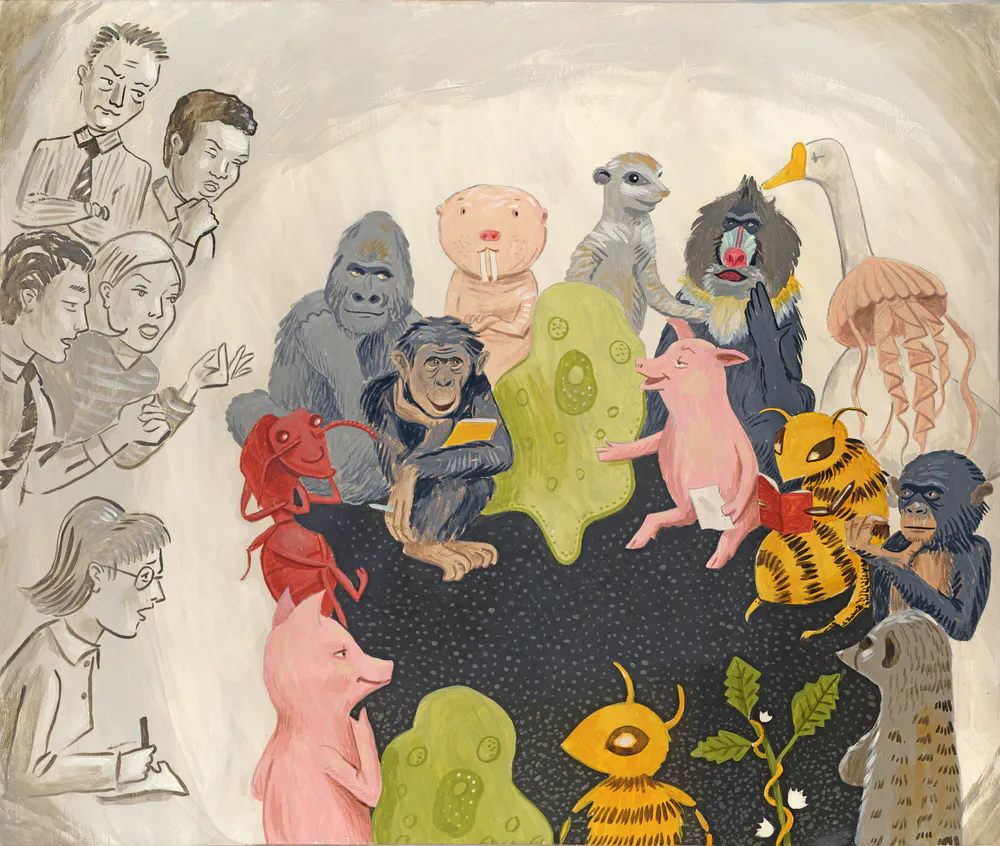
Political considerations extend beyond humans and make additional difficult but also interesting challenges for representation. Non-human Democracy
Political Representation (Stanford Encyclopedia of Philosophy)
Political representation, on almost any account, will exhibit the following five components:
- Some party that is representing (the representative, an organization, movement, state agency, etc.);
- Some party that is being represented (the constituents, the clients, etc.);
- Something that is being represented (opinions, perspectives, interests, discourses, etc.); and
- A setting within which the activity of representation is taking place (the political context).
- Something that is being left out (the opinions, interests, and perspectives not voiced).
In addition to liberal ideas of representation as a delegate or trustee relationship, recent scholarship argues for other forms of representation for disadvantaged groups.
Mediation. Williams, Melissa. ‘The Uneasy Alliance of Group Representation and Deliberative Democracy’. In Citizenship in Diverse Societies, edited by Will Kymlicka and Wayne J. Norman, 124–53. Oxford: Oxford University Press, 2000.
Advocacy. Urbinati, Nadia. ‘Representation as Advocacy: A Study of Democratic Deliberation’. Political Theory 28, no. 6 (2000): 758–86. https://doi.org/10/brm9rr.
For an overview, see Urbinati, Nadia, and Mark E. Warren. ‘The Concept of Representation in Contemporary Democratic Theory’. Annual Review of Political Science 11, no. 1 (2008): 387–412. https://doi.org/10/d8pxx2.
For forms of representations that concern nonhuman animals, see: Donaldson, Sue, and Will Kymlicka. Zoopolis: A Political Theory of Animal Rights. New York: Oxford University Press, 2011.
Scientific Representation
Scientific Representation (Stanford Encyclopedia of Philosophy)
Science provides representations of atoms, elementary particles, polymers, populations, genetic trees, economies, rational decisions, aeroplanes, earthquakes, forest fires, irrigation systems, and the world’s climate. To a large degree, humans learn about the world through these representations. There are multiple accounts of scientific representation that describe how scientific models represent their target systems.
Mental Representation
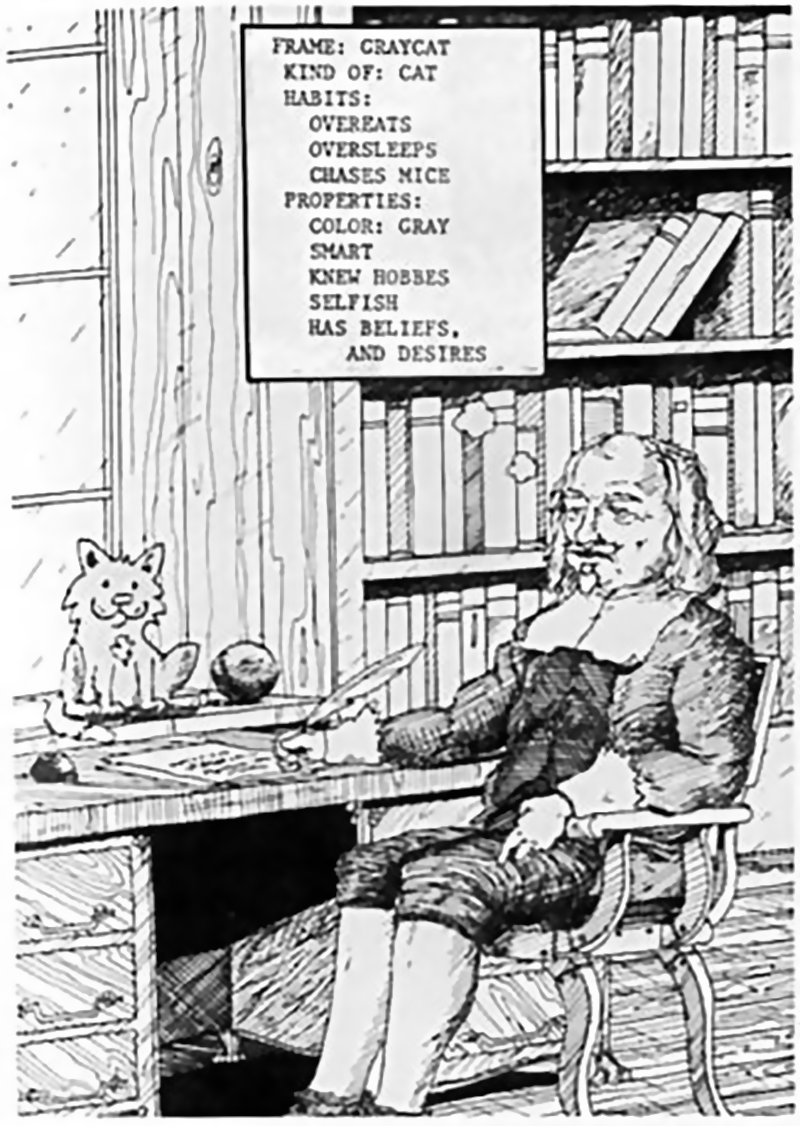
The structure of mental representation is a topic of active debate in philosophy and science. Introduction to Mental Representation
Mental Representation (Stanford Encyclopedia of Philosophy)
"'Representational Theory of Mind' that postulates the existence of semantically evaluable mental objects, including philosophy’s stock-in-trade mentalia – thoughts, concepts, percepts, ideas, impressions, notions, rules, schemas, images, phantasms, etc. – as well as the various sorts of “subpersonal” representations postulated by cognitive science."
"Such states are said to have “intentionality” – they are about or refer to things, and may be evaluated with respect to properties like consistency, truth, appropriateness and accuracy. (For example, the thought that cousins are not related is inconsistent, the belief that Elvis is dead is true, the desire to eat the moon is inappropriate, a visual experience of a ripe strawberry as red is accurate, an imaging of George Washington with dreadlocks is inaccurate.)"
Representation and Action
- The direct approach of representation focuses on the sensory side.
- Here, representations are internal reflections of external circumstances.
- They are destinations of sensory processes that translate the environmental state of affairs into a set of mental representations.
- However, an outward orientation also exists.
- Representations are the starting point for processes that lead to the external environment.
- This behavioural aspect of representation has received less attention.
- Behaviour is a phenomenon which is independent from mind. Ants, for example, behave even if it s not clear whether they have minds.
Keijzer, Fred A. Representation and Behavior. Cambridge, MA: MIT Press, 2001.
Representation and Innovation
In humans, thinking requires representation.
Cf.
- representational talkback
- emergent information
- information/knowledge gardening
Design Representation
Definitions of Design Representation
Design representation makes ideas, innovations, and futures visible and shareable.
Taxonomies of Design Representation
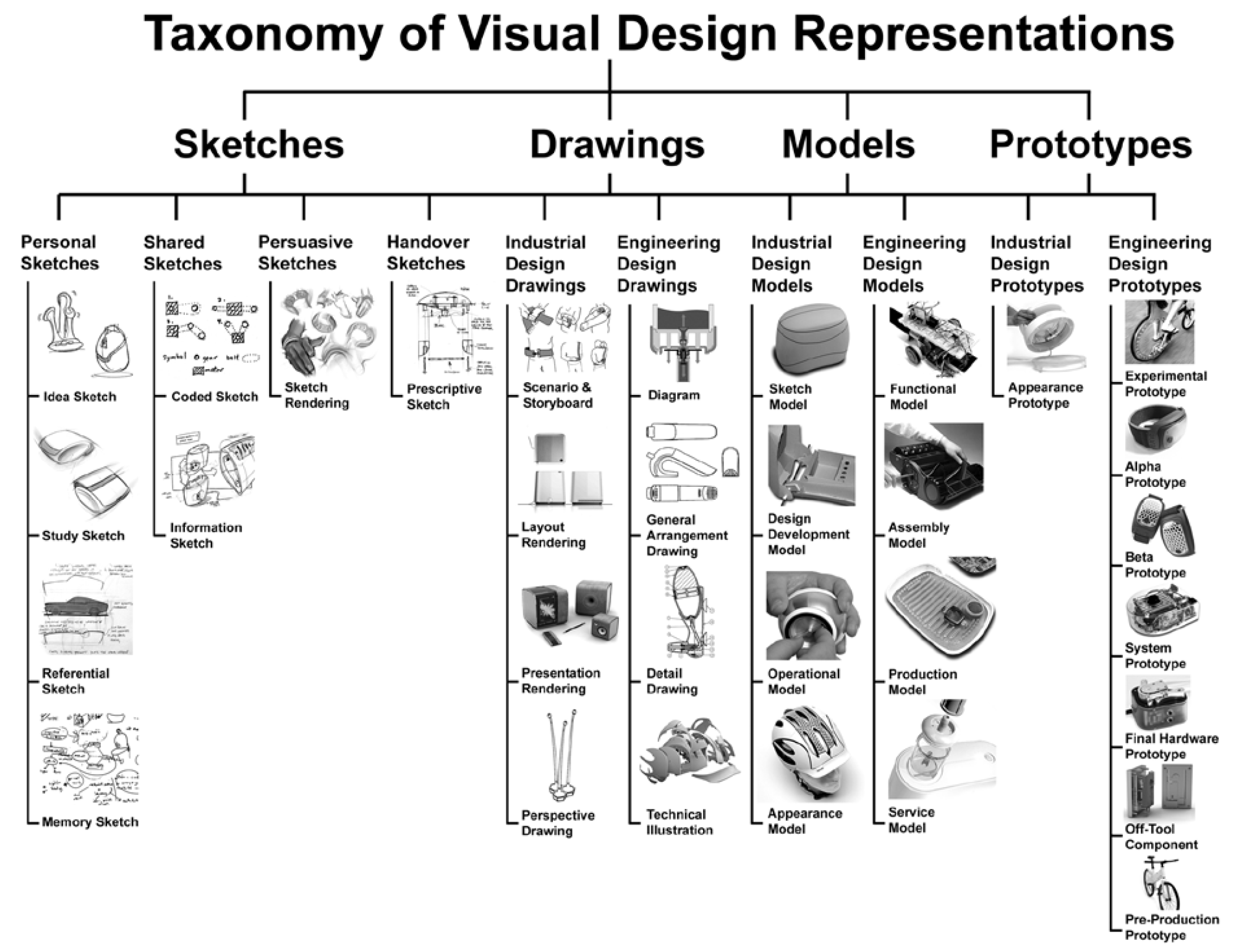
Taxonomy of visual design representations in industrial and engineering design.
Pei, Eujin, Ian Campbell, and Mark Evans. ‘A Taxonomic Classification of Visual Design Representations Used by Industrial Designers and Engineering Designers’. The Design Journal 14, no. 1 (2011): 64–91. https://doi.org/10/cp5wjp.
Graphic Design
Representation is a process through which people make something that expresses an interest in some particular aspect of something else and that is motivated by both context and intent.
Representations may be expressions of intangible ideas, concepts, or feelings in some physical form (for example, a gesture, a drawing, or a poem). They may also communicate information about tangible objects, people, or places in the real world in a different physical form (for example, diagrams, photographs, or maps). And in other instances, one representational form may be substituted for another, such as a film for an oral history or a picture of five apples for the Arabic numeral 5.
The most basic unit of representation is the sign, which is something that stands for something else to someone in some respect.
"A depiction of something (an idea, concept, quality, person, place, thing, or event) in a form other than the one in which it originated; or, a process through which such forms are created that is motivated by context and intention."
Davis, Meredith. Graphic Design Theory. New York: Thames & Hudson, 2012, 26.
Architecture
In a common understanding in architecture, representation in the design process is a visual testing of the results of the conceptual process that leads to the production of the intended object. Most architects rely on and most clients demand some visual verification of the concept, especially considering the enormous cost of materialising the concept.
Yates, Gabriela. ‘Distance and Depth’. In Design Representation, edited by International Design Thinking Research Symposium, Gabriela Goldschmidt, and William L. Porter, 3–36. London: Springer, 2004.
Parametric modelling is one form of design representation. Like any design representation, parametric modelling can be used towards several ends. "A motivation for many is form-finding, the use of a hypothesized external influence to guide the physical shape and material composition of a design. Form-finding is an extremely common strategy in engineering design, where the word optimization labels a specific formal device for discovery of utility-maximizing solutions to a set of constraints. In architecture, some of the best uses of the strategy have occurred in collaboration with engineering structural designers. Cf. Frei Otto, Cecil Balmond, Ove Arup, Edmund Happold.
Woodbury, Robert, Shane Williamson, and Philip Beesley. ‘Prarmetric Modelling as a Design Representation in Architecture: A Process Account’. 2006: Proceedings of the Canadian Engineering Education Association (CEEA), 2011. https://doi.org/10/gk78x2.
Landscape Architecture
In landscape architecture, growth of plants is the main material. The key way to engage with this material is through direct action. Here, common uses of representation as for the description of design become hard or at least less prominent.
As Raxworthy discusses:
"Representation of plant material can only ever either specify a start or provide set reactions to predicted contingencies. Any specification for maintenance must predict potential situations; this makes it the same as the planting plan in that it simulates a future, even if that future is a catastrophic one.
However, if we accept that growth is the material of plants, such an approach to change is negative and pessimistic. Since a plant will never end up looking exactly as predicted, because each plant is a genetically different individual, emerging characteristics and traits during the growth process should be encouraged and engaged with. Nevertheless, representation will never be the key to this. Instead, real-time action in response to the plant, also known as gardening, provides a better tool to optimize serendipitous characteristics emerging from growth. Representation, where it is used, should instead be post-factum, as a means of documenting effects to allow for a learning process to inform later practice."
Raxworthy, Julian. Overgrown: Practices Between Landscape Architecture & Gardening. Cambridge, MA: MIT Press, 2018.
Representation and Decision-Making
Decision-making is the generalized form of design.
Key Types of Representation
- Different types of representation in human psychology
This is a book by a Nobel Prize winner on the noise or random deviation in human judgement but also in inter-human systems. His earlier book is even more relevant because it considers (in a simplified way) human decision making as an integration of two systems: System 1 (spontaneous, fast, effort-saving) and System 2 (attempting to be rational, slow and effortful).
Kahneman, Daniel, Olivier Sibony, and Cass R. Sunstein. Noise: A Flaw in Human Judgment. London: William Collins, 2021.
Kahneman, Daniel. Thinking, Fast and Slow. New York: Farrar, Straus and Giroux, 2013.
Non-representation
Emphasise the embodied experience. Cf. Nigel Thrift
A critique of representation, especially in geography, particularly. Focuses on embodied practices which precede or exceed reflexive or cognitive understanding. Focuses on the role of the sensing body. Focuses on the now rather than on the after-stories.
Nonrepresentational Theory - an overview | ScienceDirect Topics
References
Coppi, Alessia Eletta, Alberto Cattaneo, and Jean-Luc Gurtner. ‘Exploring Visual Languages Across Vocational Professions’. International Journal for Research in Vocational Education and Training 6, no. 1 (2019): 68–96. https://doi.org/10/gpt3sv.
Dym, Clive L., and David C. Brown. Engineering Design: Representation and Reasoning. 2nd ed. 1994. Reprint, New York: Cambridge University Press, 2012.
Bodker, Susanne. 1998. “Understanding Representation in Design.” Human–Computer Interaction 13 (2): 107–25. https://doi.org/10/dhqrz9.
Problem Solving
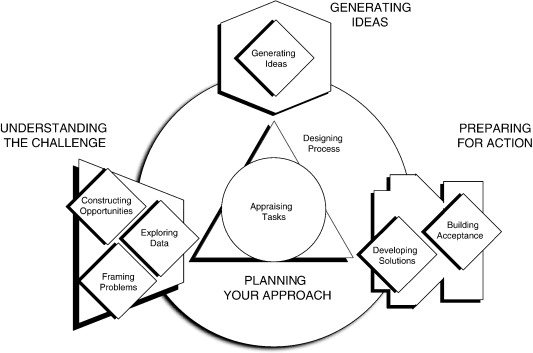
An outline of problem solving by Creative Problem Solving Group and Center for Creative Learning.
- Treffinger, Donald J., Edwin C. Selby, and Scott G. Isaksen. ‘Understanding Individual Problem-Solving Style: A Key to Learning and Applying Creative Problem Solving’. Learning and Individual Differences, Including Special Issue on Creativity, 18, no. 4 (2008): 390–401. https://doi.org/10/bfg75s.
Metacomponents of problem solving include:
- recognizing the existence of a problem
- defining the nature of the problem
- allocating mental and physical resources to solving the problem
- deciding how to represent information about the problem
- generating the set of steps needed to solve the problem
- combining these steps into a workable strategy for problem solution
- monitoring the problem-solving process while it is ongoing
- evaluating the solution to the problem after problem solving is completed
- Sternberg, Robert J. Beyond IQ: A Triarchic Theory of Human Intelligence. Cambridge: Cambridge University Press, 1984.
Sources, Examples, and Media
Snippets from Kahneman's audiobooks on decision making
Define Information
This note is about the concept of information
Key Issues
Why do we need to look at the concept and the phenomenon of information?
It is important to understand the formation of the world and the relationship of the world to life in order to change that context via design.
Large-scale data- and sensing-driven approaches to management and design stimulate further need.
This need becomes acute when design substantially or deliberately impinges on the lives of nonhuman beings (which is always, to some degree).
Overview
A good overview is:
Logan, Robert K. ‘What Is Information?: Why Is It Relativistic and What Is Its Relationship to Materiality, Meaning and Organization’. Information 3, no. 1 (2012): 68–91. https://doi.org/10/gchqgp.
It is a contested concept with many uses in different domains.
Linguistically and grammatically the word information is a noun but information occurs as a process.
- Is there only one type information or many types of information?
- How does information relate to meaning?
- Is it material, a form of energy or a pattern?
- Is it human only or do other living/nonliving forms have/produce information?
Kind, Amy, ed. The Routledge Handbook of Philosophy of Information. London: Routledge, 2016.
Related
Definitions of Information
Information is the ability to distinguish reliably among possible alternatives. Shannon (the minimal distinction between two possible messages is the fundamental binary "atom", a bit or a binary digit, 0 or 1)
To live effectively is to live with adequate information. Wiener 1
Information is a distinction that makes a difference. MacKay 2
Information is a difference that makes a difference. Bateson 3
Christoph Adami, life is information, information is the ability to make predictions with a likelihood better than chance. Genome is a repository of information about the world gathered in small bits through evolution.
Adami, Christoph. ‘What Is Information?’ Philosophical Transactions of the Royal Society A: Mathematical, Physical and Engineering Sciences 374, no. 2063 (2016): 20150230. https://doi.org/10/gd3tc4.
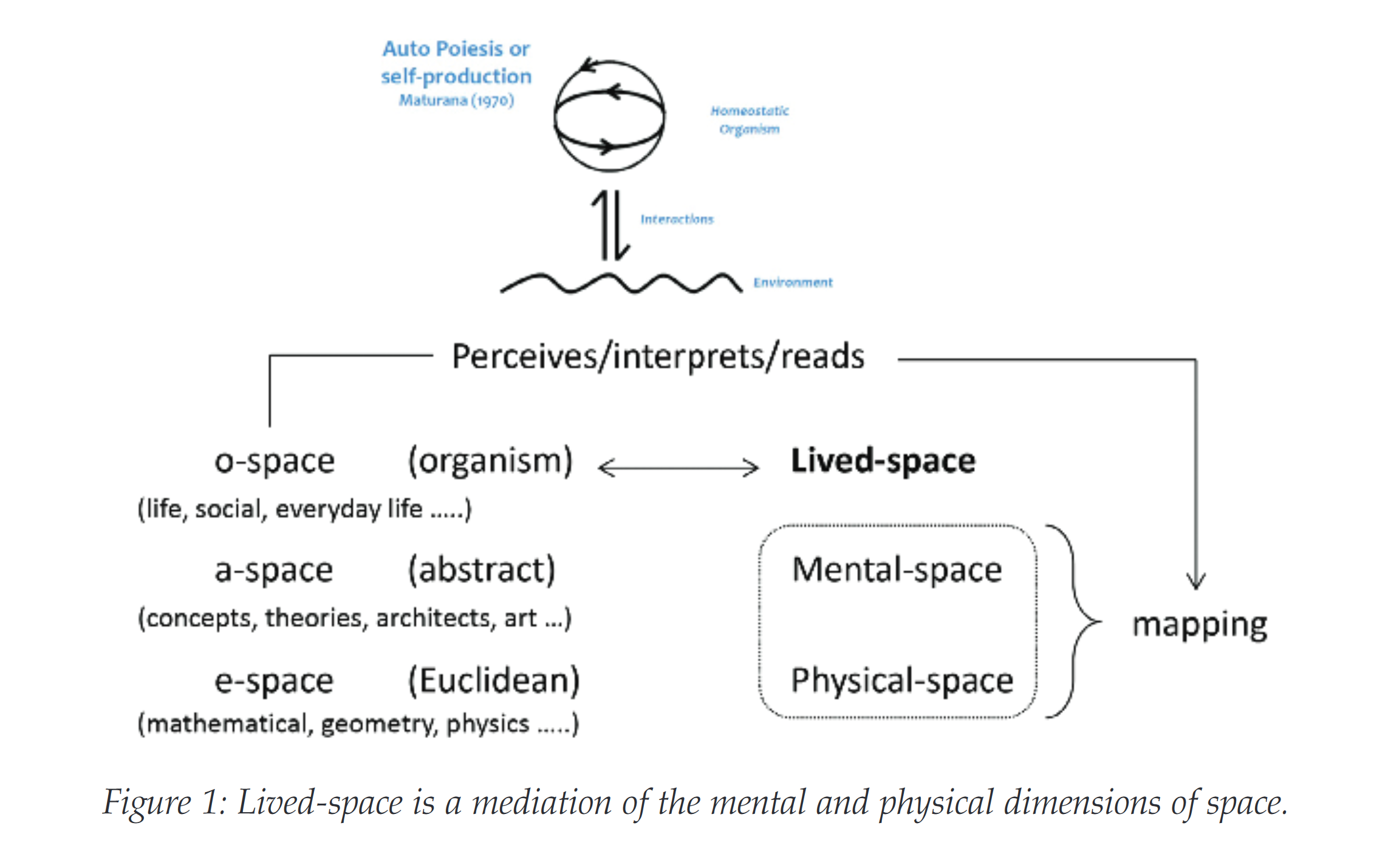
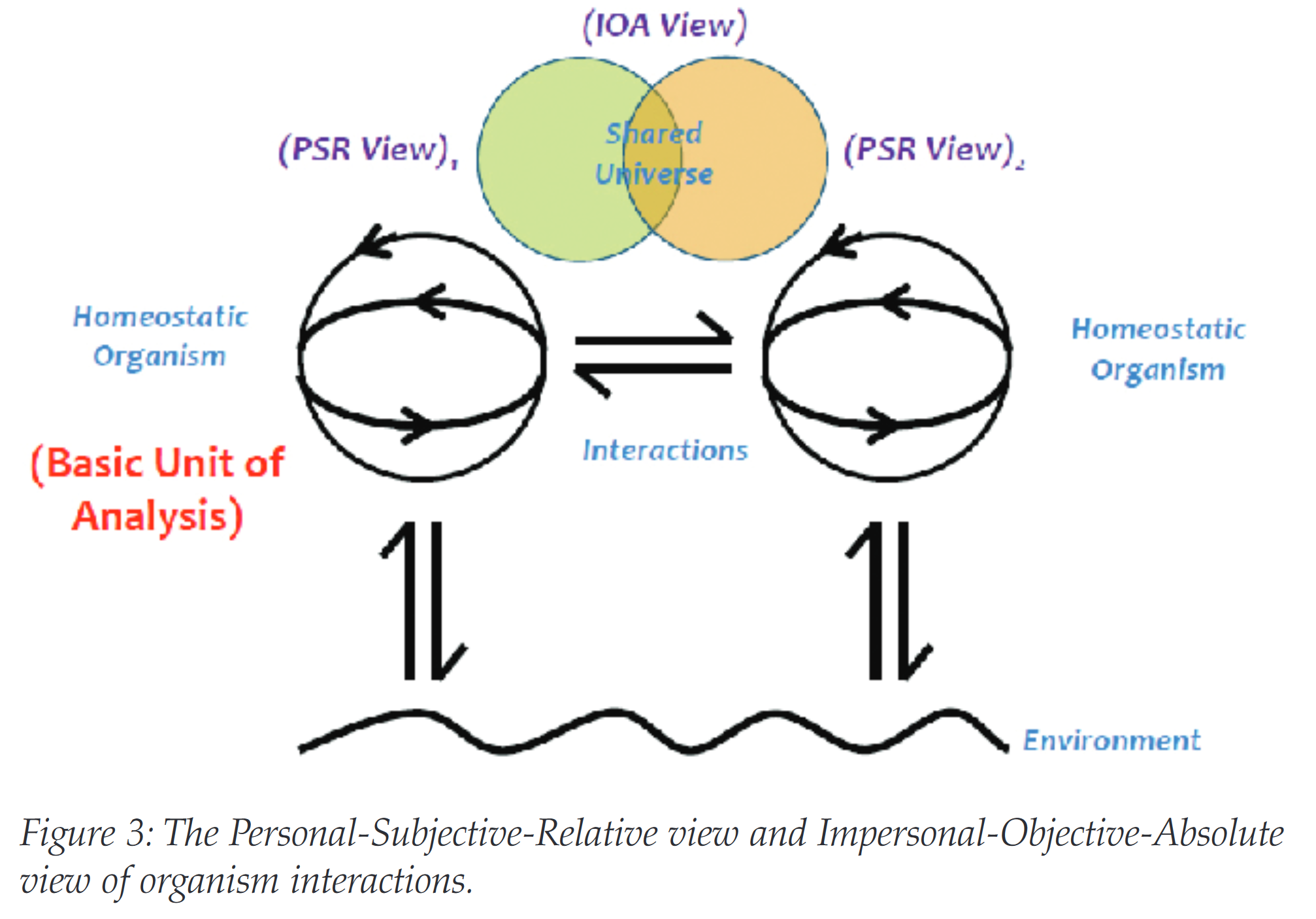
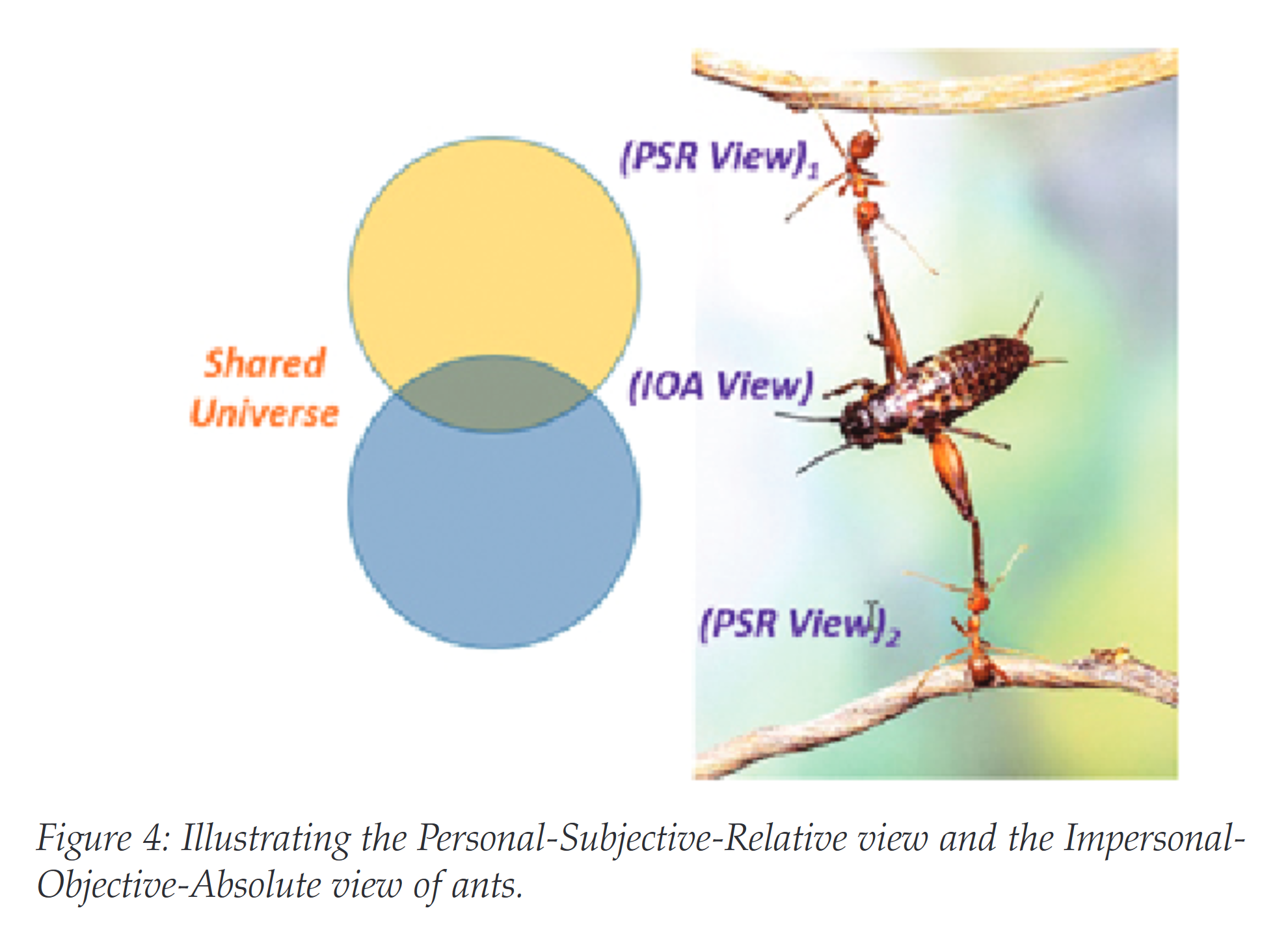
Ireland, Tim, and Jaime F. Cardenas-Garcia. ‘A Teleonomic Distributed Cognition Approach to Architectural Design’. Technoetic Arts 15, no. 1 (1 March 2017): 15–34. https://doi.org/10/gpthzk.
For a recent discussion, see:
Burgin, Mark, and Jaime F. Cárdenas-García. ‘A Dialogue Concerning the Essence and Role of Information in the World System’. Information 11, no. 9 (2020): 406. https://doi.org/10/gptjh7.
For the connection to the digital technology, see:
Cárdenas-García, Jaime F. ‘Info-Autopoiesis and Digitalisation’. Proceedings 81, no. 1 (2022): 82. https://doi.org/10.3390/proceedings2022081082.
On the connection with the overarching theories of the structure of the universe (and its self-learning capabilities), see:
Alexander, Stephon, William J. Cunningham, Jaron Lanier, Lee Smolin, Stefan Stanojevic, Michael W. Toomey, and Dave Wecker. ‘The Autodidactic Universe’. ArXiv:2104.03902, 2021.
Cárdenas-García, Jaime F. ‘The Process of Info-Autopoiesis – the Source of All Information’. Biosemiotics 13, no. 2 (2020): 199–221. https://doi.org/10/gnk7w4.
Barbieri, Marcello. “What Is Information?” Philosophical Transactions of the Royal Society A: Mathematical, Physical and Engineering Sciences 374, no. 2063 (2016): 20150060. https://doi.org/10/gd6fcg.
"Information: any factor that can affect the phenotype in ways that may (or may not) influence fitness. Consequently, phenotypic variation results from variation in the information possessed by individual organisms."
- definitions often refer to how information is used rather than on the facts from which it is extracted
- a fact becomes information once it is detected
- information is analogous to energy in being either potential or realized
Danchin, Étienne. “Avatars of Information: Towards an Inclusive Evolutionary Synthesis.” Trends in Ecology & Evolution 28, no. 6 (2013): 351–58. https://doi.org/10/f429ff.
Cf. their definition of Culture.
"Information: a reduction in uncertainty that can be quantified in a Bayesian sense by comparing a prior knowledge state to a posterior state (sensu 7). Information Ecology is not tied to any specific measurement but, for simplicity, we can estimate uncertainty in terms of the ‘probability of being wrong’ so that it ranges from 0 to 1. This probability is a product of the state space and previously obtained information. For example, without any prior knowledge, the probability of being wrong is higher for a four-sided dice than a two-sided dice (0.75 vs. 0.50). This uncertainty can be reduced with information (e.g., learning that the dice is weighted to always land on two would bring the uncertainty to 0 in both cases) and the quantity of information is measured as the reduction in uncertainty (0.75 or 0.50). Information ranges from -1 to 1, with negative information indicating a gain in uncertainty."
Bergman, Thore J., and Jacinta C. Beehner. “Information Ecology: An Integrative Framework for Studying Animal Behavior.” Trends in Ecology & Evolution 38, no. 11 (2023): 1041–50. https://doi.org/10/gst66t.
Information, Computation, and Nature
Dodig-Crnkovic, Gordana. ‘Nature as a Network of Morphological Infocomputational Processes for Cognitive Agents’. The European Physical Journal Special Topics 226, no. 2 (2017): 181–95. https://doi.org/10/f3t2ph.
Infocomputation as a way to understand ecology and sustainability.
Brenner, Joseph E. ‘The Philosophy of Ecology and Sustainability: New Logical and Informational Dimensions’. Philosophies 3, no. 2 (2018): 16. https://doi.org/10/grp3m3.
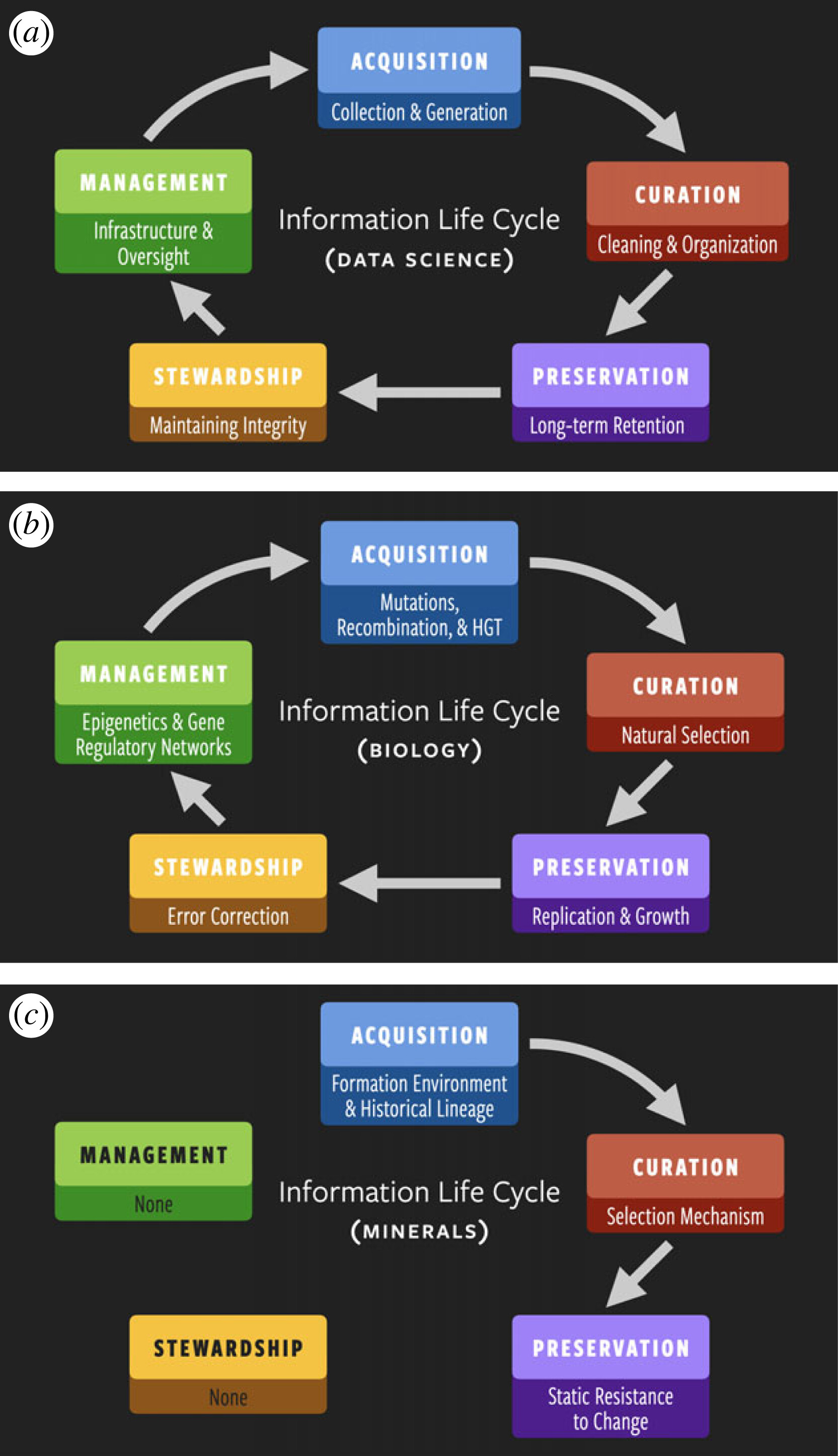
Wong, Michael L., and Anirudh Prabhu. ‘Cells as the First Data Scientists’. Journal of The Royal Society Interface 20, no. 199 (2023): 20220810. https://doi.org/10/gr542v.
Information and Life
"Every process, event, happening—call it what you will; in a word, everything that is going on in Nature means an increase of the entropy of the part of the world where it is going on. Thus a living organism continually increases its entropy—or, as you may say, produces positive entropy—and thus tends to approach the dangerous state of maximum entropy, which is death. It can only keep aloof from it, i.e., alive, by continually drawing from its environment negative entropy—which is something very positive as we shall immediately see. What an organism feeds upon is negative entropy. Or, to put it less paradoxically, the essential thing in metabolism is that the organism succeeds in freeing itself from all the entropy it cannot help producing while alive." 4
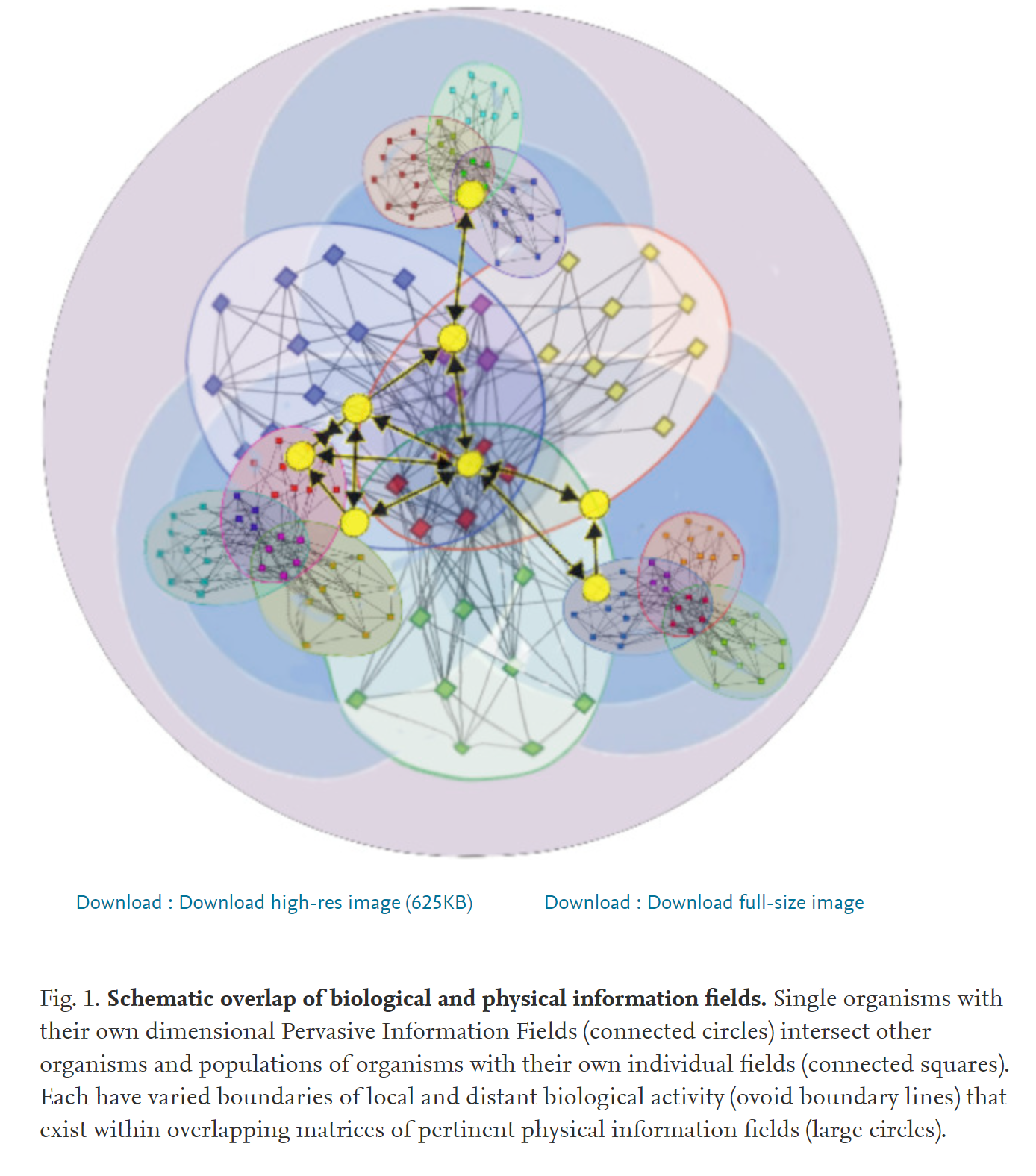
Miller, William B. ‘Biological Information Systems: Evolution as Cognition-Based Information Management’. Progress in Biophysics and Molecular Biology 134 (2018): 1–26. https://doi.org/10/ghqpft.
Evolutionary biology as an epiphenomenon of integrated self-referential information management.
Since all biological information has inherent ambiguity, living organisms have to systematically assess to maintain self-identity and homeostatic equipoise in confrontation with environmental challenges.
Miller, William B., John S. Torday, and František Baluška. ‘Biological Evolution as Defense of “Self”’. Progress in Biophysics and Molecular Biology 142 (2019): 54–74. https://doi.org/10/ggfgh7.
Küppers, Bernd-Olaf. Information and the Origin of Life. Cambridge, MA: MIT Press, 1990.
Yockey, Hubert P. Information Theory, Evolution, and the Origin of Life. Cambridge: Cambridge University Press, 2005.
Walker, Sara Imari, and Paul C. W. Davies. “The Algorithmic Origins of Life.” Journal of The Royal Society Interface 10, no. 79 (2013): 20120869. https://doi.org/10/gd6fmt.
Roederer, Juan G. Information and Its Role in Nature. Berlin: Springer, 2005.
Davies, Paul C. W., and Sara Imari Walker. “The Hidden Simplicity of Biology.” Reports on Progress in Physics 79, no. 10 (2016): 102601.
Compression
Cf. Abstraction
A common idea in studies of sensory processing.
The view that brain is an device for compressing information. Generally, that intelligence and cognition are mechanisms that gather, synthesize, compress, and convert unstructured information into useful and exploitable knowledge, cf. Demis Hassabis, of DeepMind, Stanislas Dehaene.
"Internal knowledge may be inaccurate or incomplete due to errors in sensory measurements. Some features of the environment may also be encoded inaccurately to minimize representational costs associated with their processing."
Motiwala, Asma, Sofia Soares, Bassam V. Atallah, Joseph J. Paton, and Christian K. Machens. “Efficient Coding of Cognitive Variables Underlies Dopamine Response and Choice Behavior.” Nature Neuroscience 25, no. 6 (2022): 738–48. https://doi.org/10/gqcskh.
Wolff, J. Gerard. “Information Compression as a Unifying Principle in Human Learning, Perception, and Cognition.” Complexity, 2019, e1879746. https://doi.org/10/gk78h9.
Information in Context
This also related to Knowledge and Abstraction
- Data are the pure and simple facts without any particular structure or organization, the basic atoms of information,
- Information is structured data, which adds more meaning to the data and gives them greater context and significance,
- Knowledge is the ability to use information strategically to achieve one's objectives, and
- Wisdom is the capacity to choose objectives consistent with one's values and within a larger social context.5
Information in Biology
Shannon's information is agnostic to function or meaning. by contract, biological information has to be semantic, or functional. The focus here is on the evolution of the receiver (we could call this representation?).
"A source—an entity or a process—can be said to have information when a receiver system reacts to this source in a special way. The reaction of the receiver to the source has to be such that the reaction can actually or potentially change the state of the receiver in a (usually) functional manner. Moreover, there must be a consistent relation between variations in the form of the source and the corresponding changes in the receiver." 6
Cognition limits the flow of information flow as determined by the life history of an organism, de Waal
Dickins, Thomas E. “Data and Context.” Biosemiotics 14, no. 3 (2021): 633–42. https://doi.org/10/gqd39r.
Cf. "control information". Intends to measure the functional (content and meaning) role of information in cybernetic processes (such as in living systems). "It is defined as: the capacity (know how) to control the acquisition, disposition and utilization of matter/energy in ‘purposive’ (cybernetic) processes." Can be measured as the quantity of available energy that can be controlled by a given unit of information in a given context. Other metrics are also possible including money or labour (time and energy).
Corning, Peter A. ‘Control Information Theory: The “Missing Link” in the Science of Cybernetics’. Systems Research and Behavioral Science 24, no. 3 (2007): 297–311. https://doi.org/10/dp3h37.
O’Connor, Mary I., Matthew W. Pennell, Florian Altermatt, Blake Matthews, Carlos J. Melián, and Andrew Gonzalez. ‘Principles of Ecology Revisited: Integrating Information and Ecological Theories for a More Unified Science’. Frontiers in Ecology and Evolution 7 (2019). https://doi.org/10/gkdx4q.
Szymkowiak, Jakub, and Kenneth A. Schmidt. ‘Ecology of Information Enters the Anthropocene’. Oikos 2022, no. 10 (2022): e09677. https://doi.org/10/gsm5w9.
Cf. the agential perspective in Agency.
Biological information is best understood as the interpretation (or processing) of inputs, rather than as an inherent property of inputs. It is best to define it in terms of the receiver system. A source becomes an informational input when an interpreting receiver can react to the form of the source (and variations in this form) in a functional manner.
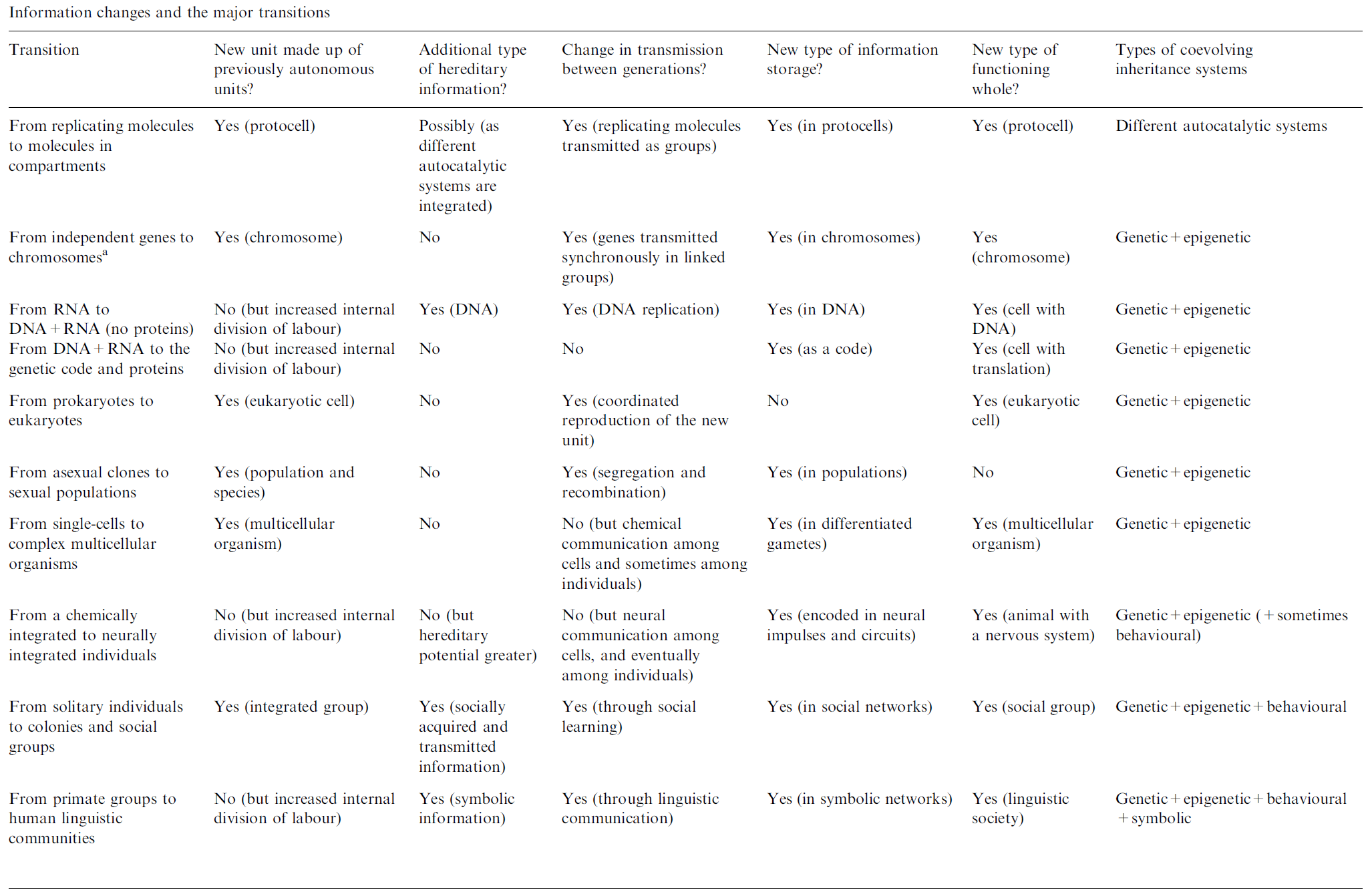
Jablonka, Eva, and Marion J. Lamb. ‘The Evolution of Information in the Major Transitions’. Journal of Theoretical Biology 239, no. 2 (2006): 236–46. https://doi.org/10/fht8hq.
Jablonka, Eva. ‘Information: Its Interpretation, Its Inheritance, and Its Sharing’. Philosophy of Science 69, no. 4 (2002): 578–605. https://doi.org/10/cwmsjs.
Can we redraw this table to include machinic means for storing and transmitting information?
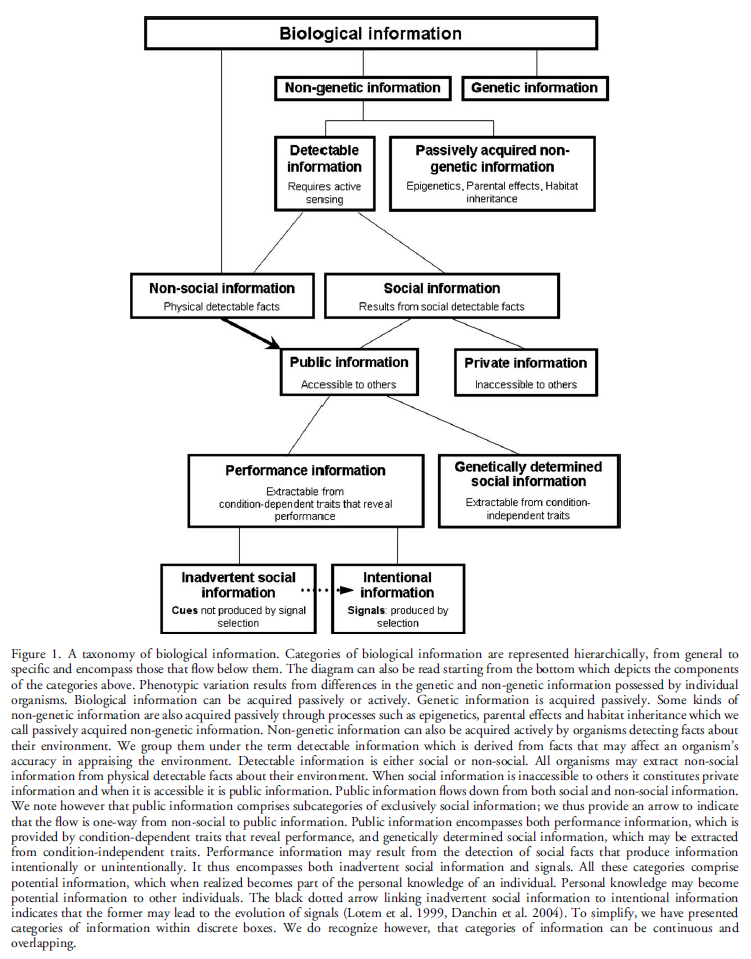
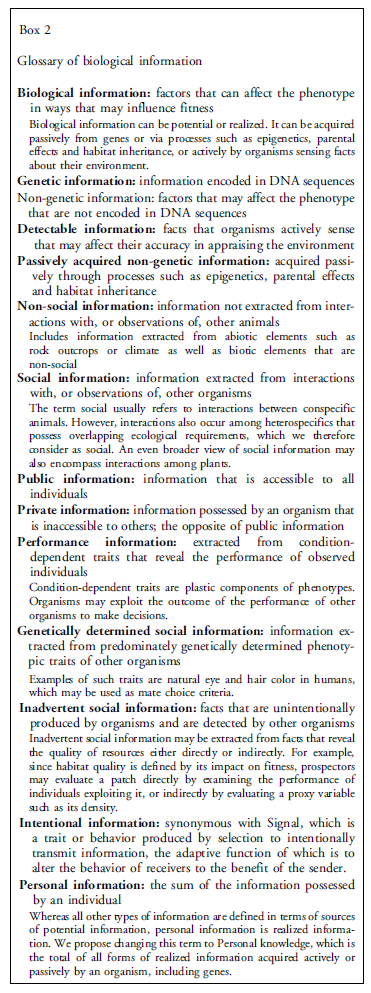
Wagner, Richard H., and Étienne Danchin. “A Taxonomy of Biological Information.” Oikos 119, no. 2 (2010): 203–9. https://doi.org/10/fg8455.
Cognitive Ecology, Ecology of Information
Cf. Agency
Dukas, Reuven, ed. Cognitive Ecology: The Evolutionary Ecology of Information Processing and Decision Making. Chicago: University of Chicago Press, 1998.
Jablonka, Eva, and Marion J. Lamb. ‘The Evolution of Information in the Major Transitions’. Journal of Theoretical Biology, 239, no. 2 (2006): 236–46. https://doi.org/10/fht8hq.
Jablonka, Eva. ‘Information: Its Interpretation, Its Inheritance, and Its Sharing’. Philosophy of Science 69, no. 4 (2002): 578–605. https://doi.org/10/cwmsjs.
Little, Chelsea J., Matteo Rizzuto, Thomas M. Luhring, Julia D. Monk, Robert J. Nowicki, Rachel E. Paseka, James C. Stegen, Celia C. Symons, Frieda B. Taub, and Jian D. L. Yen. ‘Movement with Meaning: Integrating Information into Meta-Ecology’. Oikos 2022, no. 8 (2022): e08892. https://doi.org/10/gp99rx.
Schmidt, Kenneth A., Sasha R. X. Dall, and Jan A. Van Gils. ‘The Ecology of Information: An Overview on the Ecological Significance of Making Informed Decisions’. Oikos 119, no. 2 (2010): 304–16. https://doi.org/10/b9zbhf.

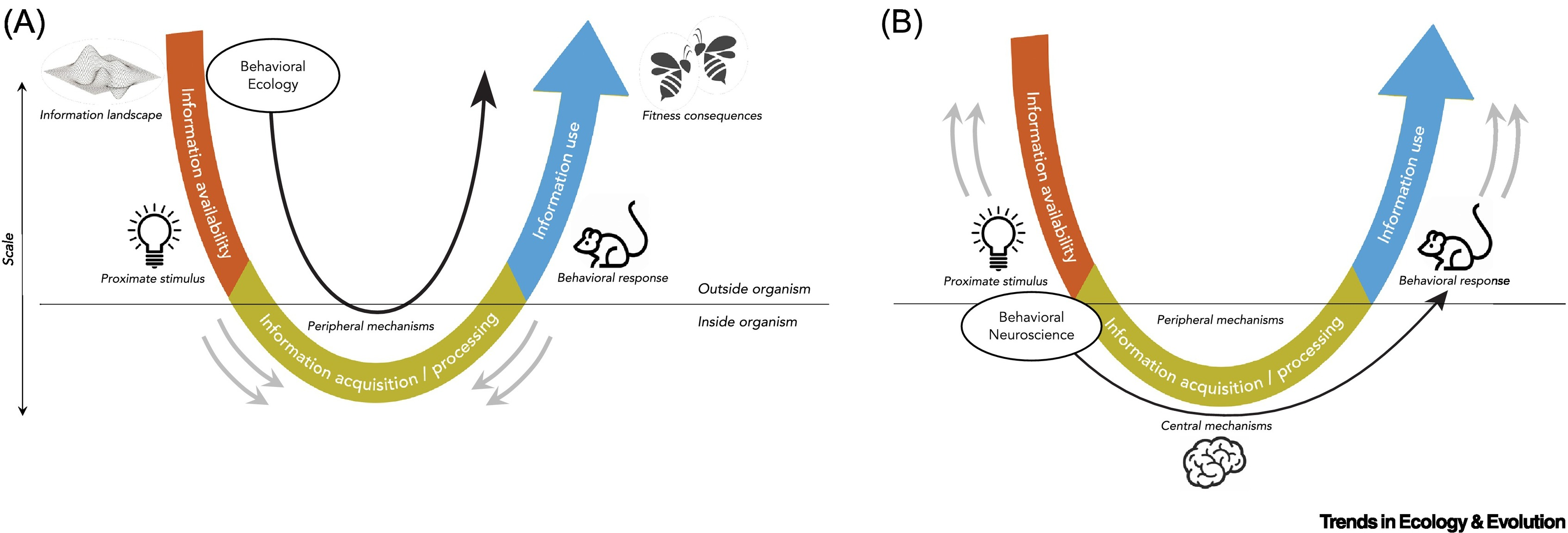
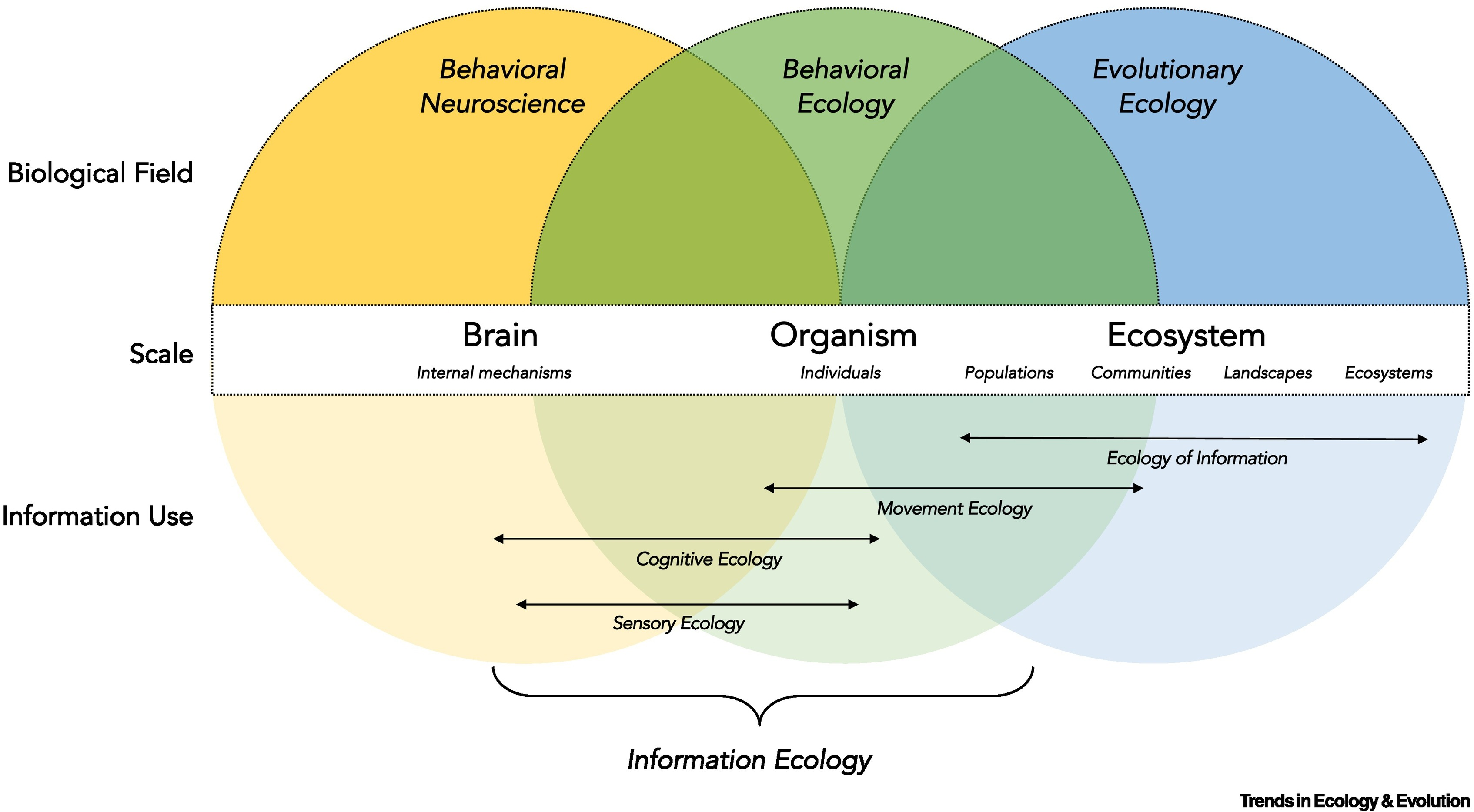
This one focuses on animals only but useful nonetheless.
Bergman, Thore J., and Jacinta C. Beehner. “Information Ecology: An Integrative Framework for Studying Animal Behavior.” Trends in Ecology & Evolution 38, no. 11 (2023): 1041–50. https://doi.org/10.1016/j.tree.2023.05.017.
Unified Views on Information
Robinson, Lyn, and David Bawden. ‘Mind the Gap: Transitions Between Concepts of Information in Varied Domains’. In Theories of Information, Communication and Knowledge: A Multidisciplinary Approach, edited by Fidelia Ibekwe-SanJuan and Thomas M. Dousa, 121–41. Dordrecht: Springer, 2014.
Terzis, George, and Robert Arp, eds. Information and Living Systems: Philosophical and Scientific Perspectives. Cambridge, MA: MIT Press, 2011.
Dodig Crnkovic, Gordana, and Mark S. Burgin, eds. Philosophy and Methodology of Information: The Study of Information in a Transdisciplinary Perspective. New Jersey: World Scientific, 2019.
Physical Computation
Informational view of the universe, nature, etc.
Dodig Crnkovic, Gordana. ‘Physical Computation as Dynamics of Form That Glues Everything Together’. Information 3, no. 2 (2012): 204–18. https://doi.org/10/f24mgs.
Dodig-Crnkovic, Gordana. ‘Natural Computational Architectures for Cognitive Info-Communication’. ArXiv:2110.06339 [Cs, q-Bio], 2021. http://arxiv.org/abs/2110.06339.
Vedral, Vlatko. Decoding Reality: The Universe As Quantum Information. Oxford: Oxford University Press, 2018.
Sayings and Perspectives
Muriel Rukeyser: "the universe is made of stories, not of atoms."
(This is only mentioned in passing in a poem about ... emotions? The Speed of Darkness, 1968)
Kurzweil describes himself "as a "patternist," someone who views patterns of information as the fundamental reality. For example, the particles composing my brain and body change within weeks, but there is a continuity to the patterns that these particles make. A story can be regarded as a meaningful pattern of information, so we can interpret Muriel Rukeyser's aphorism from this perspective."
Evolution (biological, cultural and technical) is a process of creating patterns of increasing order.
Order is information that fits a purpose. The measure of order is the measure of how well the information fits the purpose. For biological beings, the purpose is to survive.
Kurzweil, Ray. The Singularity Is Near: When Humans Transcend Biology. New York: Viking, 2005.
References
Burgin, Mark. Theory of Information: Fundamentality, Diversity and Unification. Hackensack: World Scientific, 2010.
Hofkirchner, Wolfgang. Emergent Information: A Unified Theory of Information Framework. Singapore: World Scientific, 2013.
Schumacher, Benjamin. The Science of Information: From Language to Black Holes. Chantilly: The Great Courses, 2018.
Scharf, Caleb, and Olaf Witkowski. “Rebuilding the Habitable Zone from the Bottom up with Computational Zones.” Astrobiology 24, no. 6 (2024): 613–27. https://doi.org/10/gt7gqp.
Footnotes
Weiner, Norbert. The Human Use of Human Beings. Boston: Houghton Mifflin, 1950.˄
MacKay, Donald M. Information, Mechanism and Meaning. 1969. Reprint, Cambridge, MA: MIT Press, 1969.˄
Bateson, Gregory. Steps to an Ecology of Mind: Collected Essays in Anthropology, Psychiatry, Evolution, and Epistemology. 1972. Reprint, Northvale: Aronson, 1987.˄
Dall, Sasha R. X., Luc-Alain Giraldeau, Ola Olsson, John M. McNamara, and David W. Stephens. “Information and Its Use by Animals in Evolutionary Ecology.” Trends in Ecology & Evolution 20, no. 4 (April 1, 2005): 187–93. https://doi.org/10/dhkr3v.˄
Schrödinger, Erwin. ‘What Is Life?’ In What Is Life? The Physical Aspect of the Living Cell; with, Mind and Matter and Autobiographical Sketches, Part 1. 1944. Reprint, Cambridge: Cambridge University Press, 1992.˄
Logan, Robert K., and Louis W. Stokes. Collaborate to Compete: Driving Profitability in the Knowledge Economy. Etobicoke: Wiley, 2003.˄
Jablonka, Eva. ‘Information: Its Interpretation, Its Inheritance, and Its Sharing’. Philosophy of Science 69, no. 4 (2002): 578–605. https://doi.org/10/cwmsjs, 582.˄
Define Communication
Slijepcevic, Predrag. ‘Principles of Information Processing and Natural Learning in Biological Systems’. Journal for General Philosophy of Science 52, no. 2 (2021): 227–45. https://doi.org/10/gr649k.
“Control information” maintains organism–environment interactions. 1
The biosphere is the distributed network of communicative interactions between biological systems, or the interactome.
Techniques
A digital recipe for scientific botanical illustration:
Jonathon Turnbull et al., ‘Digital Ecologies: Materialities, Encounters, Governance’, Progress in Environmental Geography, 2022, 275396872211456, https://doi.org/10/grkp5n.
Imaging
An exhibition on plants that is relevant.
Green Modernism – The new view on plants
An article on imaging within it: Imaging – Green Modernism
Designing as Activism
References
Zylinska, Joanna. Nonhuman Photography. Cambridge, MA: The MIT Press, 2017.
Subnotes
Footnotes
Corning, Peter A. ‘Control Information Theory: The “Missing Link” in the Science of Cybernetics’. Systems Research and Behavioral Science 24, no. 3 (2007): 297–311. https://doi.org/10/dp3h37.˄